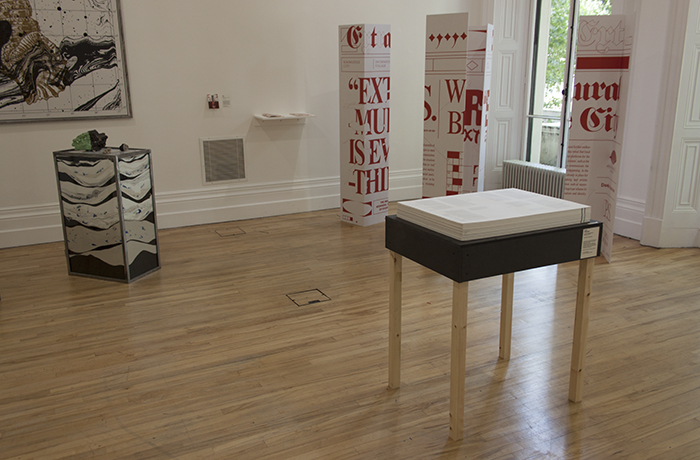From the moment that Marcel Duchamp signed an industrially produced urinal R. Mutt and submitted it for exhibition at the Society of Independent Artists, understanding the production of art became less concerned with the objective questions of who or how, and focused more on the subjective why.
The long-term influence of Duchamp’s ready-mades has been to question the relationship between physical production and creative authorship. The artistic author is now, for the most part, concerned with the establishment of context as opposed to the creation of content; positioning objects and ideas in such a way that they gain new meaning and relevance. This huge shift has resulted in a conceptualization of artistic practice, as ideas have been allowed to take precedence above the objects that had previously only ever represented them anyway. It is no longer the case that the success of an artwork can be judged through an assessment of its form. What it says is now equal to, if not prized higher, than how it looks or even what it is. And as such communication has become central to the creation of contemporary art.
The art gallery is no longer simply a place in which the viewer may find “static” objects that dictate a view of the world very much from the perspective of the authorial Artist. Instead it has morphed to become somewhere that we enter into to engage with ideas—that causes us to reconsider the world around us. Within this alternate model of the gallery, as the setting for discussion and communication, the objects themselves and the ways that they are displayed should not aim to "tell" the viewer specific things, they should simply provide the starting point for a conversation, in which the visitor takes an active role.

This is what the curator Alexander Dorner was aiming at when he described the Hanover Museum under his directorship as a Kraftwerk (powerstation) in the 1920s. This is an incredibly early example of an approach to the production and curation of art as a socially generative practice, in which the creation of new and collective knowledge is the sense by which we judge an exhibition valuable. When Dorner stated, “The idea of process has penetrated our system of certainties,” he was directly questioning the concept of the exhibition as a location for the elevation of finished outcomes, often quite literally, on pedestals. And through doing so, he prefigured the post-structuralist critique of the stability of the text and the status of its author by some forty-plus years.
Hans Ulrich Obrist, writing on the legacy of Dorner, suggests that “a truly contemporary exhibition with its striking quality of ‘unfinishedness’ and incompleteness would trigger pars pro toto participation. The non linear displays would also allow the viewer to permanently create—and question—his or her own song lines.” This new economy of the exhibition is one in which consumption has reverted to a state of further production. The emphasis is placed on the reader, and the notion of the definitive author is reduced.
As conceptualism “dematerialized” artistic practice, and removed the dependence on aesthetics, the logical direction that many artists began to move toward was the production of texts. Within the traditional context of art, the text was certainly not considered an object; as in comparison with a marble sculpture or an oil painting its status was far closer to the “concept” than to the “thing.” This has ultimately resulted in the rise of a writing practice within the arts. As artists have liberated themselves further and further from the constraints of a traditional dependence on “form,” the written word has come ever closer to the forefront of artistic practice.
In line with this shift in medium, the art market has been forced to move towards an embrace of the model of the publishing industry, in which the art object is perhaps no longer associated so much with a singular outcome with an immense object value—placed inside a museum for people to pay to see, or in a gallery for sale. It has instead utilized one where there is an edition which can be distributed widely. As these objects are sold multiple viewers can now take ownership of the work in a truly consumerist sense.
As large a shift as this is, to suggest that written art somehow gets around the issue of material existence is, of course, fundamentally mistaken. These works may still be produced largely as commodities, where the underlying aim is a financial one. The notion of the aesthetic is still undeniably present in the world of art publishing, it is just the case that our desire for beautiful objects is now fulfilled by layout and letterform. As any graphic designer will tell you, a text can certainly be a thing of beauty, but the “image” of language is certainly not directly representational.
Perhaps then we should view this shift toward writing not as the apex of conceptualism, as even beyond a consideration of aesthetics, to look at these texts in the context of graphic design only highlights the sense of objectification and the value of material existence. Instead I would like to suggest that we approach these documents simply as an advance in the history of abstraction.

Throughout Western art history, from the latter nineteenth through the twentieth centuries, and particularly in the realm of painting, there has been an ongoing process of abstraction in which I believe there can be seen an interesting parallel to the aims of conceptualism. From the Impressionists onward, the idea of representing the world as a place of definition through the creation of directly “realistic” images was slowly but steadily challenged.
Throughout this process the perception of the viewer gained precedence, as content became something up for interpretation and discussion as opposed to specifically presented. It seems to me that within the history of Western art, it is, in fact, at this moment that we begin to shift from being viewers to readers.
This is an edited section from Robert’s essay "And the Word was made flesh… full of grace and truth," currently being distributed at Show RCA 2015, running through July 5 at the Royal College of Art, London, from which the above images are taken.

